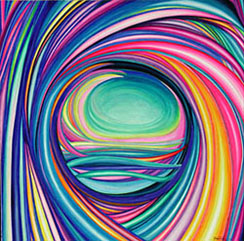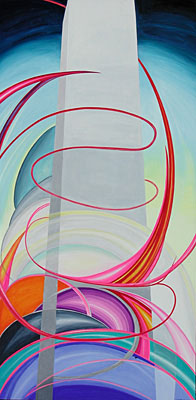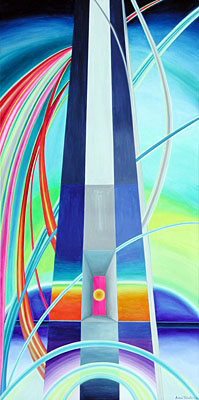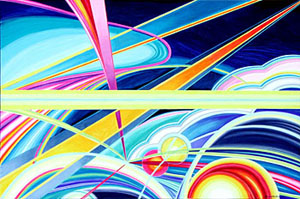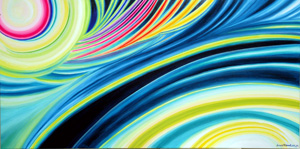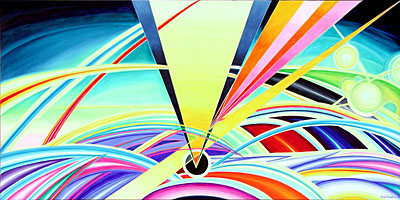The challenge faced by Rosario Tornatore in a recent cycle of paintings - presented here in its entirety for the first time - concerns a subject that has often characterised relations between the world of art and the world of science. Relations that, in the sphere of modern art, have become increasingly closer, almost obligatory, influencing the foremost avant-garde movements from cubism to futurism, from abstractionism to informal and spatialism; albeit in different forms, all their languages adopted the intuitions and knowledge of the modern conquests of scientific thinking.
Perhaps this cultural condition can explain why Tornatore's research, practically from the start, has also taken the routes laid out by those historical movements. Taken up and modified by the artist with an equally radical commitment, with the aim (later to become truly indispensable for him) of directing and shaping his own experiences on the basis of a fundamental conceptual and formal link with certain cognitive principles. Principles that enabled the discovery of otherwise unexplainable natural phenomena and, as a result, led to the mathematical coding of some of the primary properties of the living world, thanks especially to Einstein's physics and the quantum theory, but also recent research into molecular genetics and the sub-atomic world.
Tornatore has absorbed this knowledge in a particularly sharp manner, exploiting it in his need to extend and enrich his own thoughts and imagination so as to bring out those secret but crystal-clear spiritual moments that have so far permitted him to reach new cognitive and linguistic horizons. His aim is to translate into painting and sculpture the methodical essentiality that permeates and unites the complex, multiple “figures” of the universe - still largely unknown to science and art.
Just a few years ago, his formal paintings used a fanciful, abundant, expressive vitality (with even neo-baroque and neo-liberty elements) to explain a figurative reality with a wealth of wonderful biomorphic references to proliferate procreative processes of the world of nature: gigantic branches, turbulent waves, telluric explosions, volcanic flashes, a movement of polychrome lines that burst out of the surface of the paintings with magnetic force and inescapable enchantment.
Even the tendency to add some gratifying decorative element - due to an undeniable skill born out of experience - didn't prevent the artist from anyway applying, especially in his 1970s works, a pictorial structural resoluteness to sum up the profiles and rhythms of those abstract figures that would pass into future works, aiming in this way to transmit the dynamic movement of those natural evolutions. Sometimes, the faces of mythical characters appeared between splashes of fiery colour, their features still noble and classic, bringing to mind the ideal figures of Mediterranean art.
This mingling of figures and abstract elements, images and geometries, materials associated with symbolic references, appeared unusual. Yet at the same time, the contrast of those linguistic extremes seemed entirely alleviated in the flowing deployment of an allegory of colour based on a luminism that evoked Eden-like splendours.
But Tornatore had already arrived, by his own means, at a sort of visual cinetism for which he often found himself linked with the protagonists of Optical Art (like Le Parc and Vasarely), who he probably met during his Paris years. The geometric grids onto which the artist projected his typically bright chromatic and spatial creations tended, however, to determine a perspective lattice still based on Alberti's style, very unlike the grid distortions with the perturbing perceptive illusionism of the neo-gestalt visual language.
For Tornatore in fact, the progressive squares marked out a different spatial trend, associating the geometry with a renewed structural equilibrium of the sculptural planes. The rational pattern was a background for the impetuously overflowing plots of the various colour bands, arranged according to a free series of registers, sometimes even intensely conflicting but related in any case to the task of highlighting the single meaning of an original, absolute lyricism. A miraculous visual material, symbolic and exuberant, studded the patterns of the colour group movements, conjuring up the combinatory processes of an alchemy that was above all luminological.
And precisely the predominance of a brilliant revelation amid those cadenced geometric statements should have immediately told his authoritative commentators which speculative references were actually guiding the artist's efforts to conjugate, in an entirely different way, that language of the same “concretist” origin. He wanted to express it, on the basis of a suitable vocation, more in terms of lyrical abstraction than perceptive scientism.
In other words, Tornatore was going beyond the exacting bonds of a “psychology of form”. In fact he perhaps continued along the route of Kandinsky's “spiritual” conception of inner freedom and self-reflective testing to justify and qualify precisely the validity of a different path, in order to freely represent new, imaginative worlds in the same way.
This resolving proclamation would subsequently be confirmed in the most complete, decisive manner, following the sensational developments that led his research towards a relative cosmological vision, thereby allowing him to access the conceptual and scientific models of the present time with marvellous portrayals. At the same time confirming the idea of nature as the infinite manifestation of transcendence, as the actual form of beauty - perhaps not fully discernible but still to be explored and contemplated, to be conceived as a place of both immeasurable physical events and sublime visual emotions.
But first he had to free the figures once and for all from the persisting fanciful and mythological representations and from the high-flown metaphors of an “abstract” naturalism. For this reason, he had to examine the original sources of these “inner landscapes” consisting of dreamlike drives and dazzling phantasmagoria. The aim was to extol, with extreme purity, the parallel harmonies of creation, of that enigmatic reality that surrounds the origin of the universe and the essence of every form of life, including the experience of "being" that the language of art, according to philosopher Martin Heidegger, builds “poetically”. Thanks to certain spirits within the same line of thinking, his recent paintings have been characterised by highly imaginative cosmological projections that have matured in the transit from the former, continually transformed stylisation of natural organisms to the later shapes of pointed objects darting between the sky and the sea on undefined, boundless horizons.
Tornatore has never renounced a deep yearning to visualise music, that has been with him since he was young. He is convinced, like Kandinsky, that it is the most spiritual expression and that the various arts should lean towards it. He will even attempt to find and listen to the resonances of a natural symphony and then, in his painting, attribute the linear and chromatic elements, the spatial trends and rhythmic developments, ultimately shaping and focusing the pliability of those forms of the organic and inorganic world now transformed into concise though magnificent abstract figures similar to specific phenomenologies of the macro-cosmic world. For him, the music of nature is, in any case, the original language of the soul, of the “fiat” (essence of the light) that appears and spreads in every aspect of the subjective and objective world. Every attempt by art to truly listen should therefore become a way of questioning the depth of our vision of creativity itself.
Perhaps it's also for this reason that the pulsing, poetic nucleus of the artist must be recognised in the conception that he established at the start of his work - in the origins of a colour-light. In other words, in the formulation that, after the basic tests of his academic training, he explicitly tried out while searching for an exclusive luminous trend that went well beyond the splendour of the colours of his surroundings. In many ways, the same future developments are included in those premises along with (above all) the reasons that led him into linguistic contexts of European abstraction, at the meeting point between neo-concretism and self-reflective analytics. Bypassing the topological syntax of metrics measured only against elementary and pedantically repeated geometric relations, with his latest works he has managed to give shape and form to the effusive spatial energies of light, so that it ostensively becomes the primary idea - in fact, the ontological substance of the pictorial event.
In his current work, the concept of light-shape is expressed within a strictly rational process that the artist observes with careful analysis in his linguistic utterances. It's a process that's intense yet risky so, to avoid repressing the power of a restless spirituality and an exclusive sensitivity, he is forced to deny every geometric "base" in order to find a higher degree of harmony in the dialectical interaction of elements that consolidate the subtlety of his intellectual search for the expressive magic of refined formal inventions. His painting style adopts a metaphysical idea of “light”. The perceptible phenomena of “lumen”, “radius” and “splendour” - aspects that configure these works - are therefore the cognitive transit and the visible pattern that animates every “colour”, every “figure” of the multitude of imaginative worlds that this work evokes with the indescribable flagrancy of a visual music, a wealth of accents, rhythms and shapes in the same infinitude as the pictorial context. Painting asks merely to be just that - "painting". This is its “science”, its epistemological territory, so no-one could believe (it would be misleading in relation to the concrete meaning of Tornatore's artistic and conceptual act) that he intends to simulate, in a sort of fantastic fable, any representation -albeit hypothetical - of the physics of the universe. Nonetheless, these “worlds”, although clearly virtual, open up “visions” that appear to result from possible sounds and shapes of the universe. The painted surfaces seem to encompass and describe the interference of gravitational bands, registering the movement of waves and elements orbiting in space and translated to the pictorial sphere. This sphere becomes, in an evocative sense, a field creating - and permeated by - electromagnetic energies producing extraordinary trajectories, perhaps suggested by Einstein's concept of the space-time curve. Consequently, each image that he produces in his painting assumes the “figure” of energetics of forces identified with the dynamics of a fluctuating and vital geometry of light, establishing new and unforeseen relations between light and colour, shape and space. A dual movement of expansion and concentration spreads in every direction on the surfaces of the paintings and sculptures. A dynamis of glowing and iridescent spectrums, of vibrating volumes charged with astonishing energies in a multitude of unknown stereometric qualities. Orphean monads form and sparkle in Tornatore's splendid skies with a light, both physical and metaphysical, that brings with it unspeakable spiritual resonances; the hidden sounds of the artist's soul echo with that yearning for infinity that produces and nourishes the light.
This is why even a renewed poetic diction of futurist dynamism and its symbolic origins can be glimpsed behind this style of painting. Especially with the prismatic iridescent cells of the most precursory Balla and, at the same time and with an otherwise radical reintroduction, the crucial problems of Delaunay works and the Russian “suprematists” but, above all, the striking intuitions formulated by Giordano Bruno with his theory of the “possible worlds”. Skies of possible worlds are also depicted in the artist's most recent works, that aim to visualise and describe not only music of the “higher spheres” but also the secret variations that govern the order of creation and, in parallel (as the knowledge is only conceded to the spirit, that can truly reflect it), the order of that property which platonically belongs to art as the reflected mimesis of the supersensible and the ultra-phenomenal.
In this case, attention should also be paid to the titles of the individual paintings, to reconcile the images with the emblematically insidious meaning behind the concepts that transmit the right atmosphere of that image (as bright as it is sharp). In Tornatore's “apparitions”, in the diagrams of luminous structures, it's essentially the mystery of painting that expresses itself. Mystery that, by its very nature, is never completely soundable, but returns, every time, as a “world” and as the method - equally incomparable - of a constantly new experience of the world. In this way, and not only symbolically, the artist lights up extreme dialectical oppositions, from the incandescent reds to the icy whites, from the sunny yellows to the deep blues. All the shades of the spectrum are plotted and interwoven in a previously unseen concerted piece at the peak of an immanent lyrical amazement that seems to permeate the electric and energy motility of those “skies”, now driven to expand beyond the edges of the painting and into the environment that receives them, where it continues to regally act with great beauty. Tornatore's imagery therefore aims to visualise the possible colours of infinity, outlining a complex topology of “high temperature” light and using this material to build ideal images of possible cosmic architectures. And so the artist's creation of a luminous revelation unfolds, dominating and exceeding the limits of a spatiality that can still be geometrically configured because the pictorial event opens up to a dimensional variety, a condition of unending change that was in turn produced by a construction principle revealing a yearning for another transcendent nature.
At this point, the solar fullness of Tornatore's characteristic chromatisms blends with the incandescent transparency of a different light - not only sensitive but also mental, spiritual, aiming to irradiate the beats of that mysterious heavenly dance that moves everything - natural and supernatural - in the empito of an identical, vital effort. These are the reasons behind the ethereal iridescence that his painting now searches for. The refined glazing and the wonderful movements of the areas of light - the result of a fluency of hand and thought, lightness and grace with intelligence and emotivity - both lavished with spirituality. Weighty clues to a creative season not only fruitful but also of rare poetic intensity. These are the main factors determining the erratic yet upward movement of the forms in space, simply substantiated by the luminous revelation and by its countless “evolutions” containing within them the figures of new dimensions of the “worlds”, of their specific magnetism that flows back into the living material of the visible and the soul with the power of a glance that reveals otherwise unreachable depths right at the tip of its ideation and knowledge.
…Tornatore brings the vision of an immeasurable reality into the floodlights of the kaleidoscopic theatre of modern art. His current “images” play an important role in the transfiguration process with which he recreates the mysterious energies of the cosmos and the psyche, via a poetic imagination representing the possible geometries of the essence of light.
It's well-known that the luminological way of thinking boasts a long history, from the metaphysical observations of Grossatesta to the optic cosmogonies of Cusano, from the uranographies of the 17th century painters to - in most recent times - the “black holes” of Vedova and the “astral maps” of Kieffer, and now the “cosmocromie” of Tornatore. Radiant musical scores perhaps provoked (drawing on certain categories of medieval theology) by the “visus interior” itself. This is attested by the fact that, in the circuit of the giddy spatial emergencies of colour, of the helicoidal parabolas of the various linear outlines, of the intersected vectorial forms, each style element put into practice by the artist to build up that image tends to ascend wonderfully towards the “lumen proprium” - the visible reflection of that place-non-place of the lux that is in itself infigurable as it is absolute before and absolute after. On its threshold, the latest works show the sharply visionary glance of Tornatore which, in fact, conveys some new “sign” of that paradise and its unattainable magnificence.
Toni Toniato |
